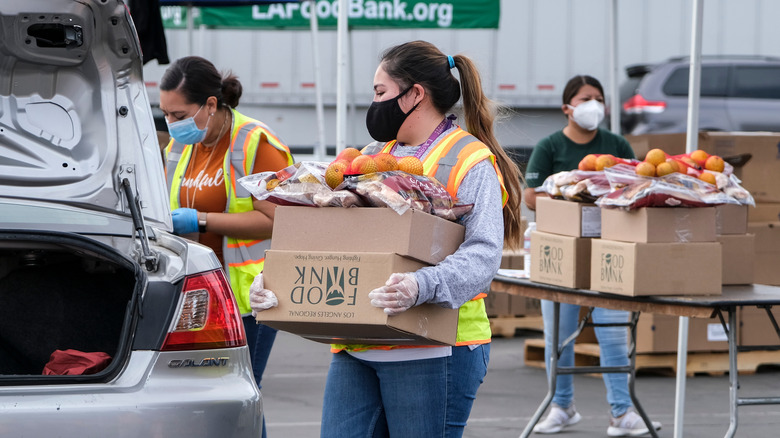New USDA Study Reveals Truth About Nationwide Food Insecurity
This week, the USDA released the 2021 results of its annual study on food insecurity in the United States, and the raw numbers are staggering. In 2021, 13.5 million U.S. households were dealing with some level of food insecurity – which means that at some time or another during the year in question, a given household found itself without adequate food to support an active and healthy lifestyle for all of its members (via Feeding America). Further, of these households, roughly a third experienced food security on a severe level, which is defined by the Food and Agriculture Organization of the United Nations, as circumstances in which members of the household went one or more days without food during the course of the year. This news comes at the heels of reports that our nation's free-school-meals-for-all-students program, which had been in effect since the early days of the COVID-19 pandemic, is ramping down and is set to end for good in summer 2023 (via Forbes).
Still, despite the COVID-19 pandemic, food insecurity levels in 2021 were roughly on par with those in 2019 and 2020. In fact, food insecurity in the United States has been on an overall decline since as far back as 2011, 2021 included, according to a USDA graph. Moreover, zooming in from the big picture of nationwide food insecurity to specific demographics, 2021 saw significant declines in food insecurity in several population subgroups.
Some groups saw improvement, while others struggled more
Alarming as the 2021 data on food insecurity in the United States may be, it's still better than it has been in more than a decade. In 2011, food insecurity touched nearly 15% of all U.S. households (with 6% facing severe levels, according to the USDA). By 2018, food insecurity had fallen to 10.5% (with 4.11% affected severely). For many, this was something to cheer about because it was the first time that the annual food insecurity rate for the U.S. had dipped below its pre-recession 2007 level of 11.1%. So, if you're up for looking at the brighter side of things, then you'll want to know that in 2021, the nationwide food insecurity rate fell to 10.2% (with 3.8% affected severely). This overall decrease from 2020 levels (10.5% and 3.9%) isn't statistically significant for research purposes, but some demographic subgroups did experience statistically significant decreases in their respective rates of food insecurity for 2021. Unfortunately, some subgroups also struggled more than they had in previous years.
In particular, food insecurity levels rose for households without children, especially for women living alone and elderly people living alone, per the USDA's 2021 report. On the other hand, subgroups that saw a decrease in the prevalence of food insecurity included households with a non-Hispanic Black person as the leaseholder, all low-income households, and households in the South. Households with children — including married couples with children, single mothers with children, households with children under age 18, and households with children under age 6 — saw a decrease in food insecurity as well. This is in line with the overall finding that child food insecurity is also down significantly from 7.6% of children in 2020 to 6.2% in 2021. Only time will tell whether the aforementioned demise of universal school meal programs in most states might reverse the trend.

